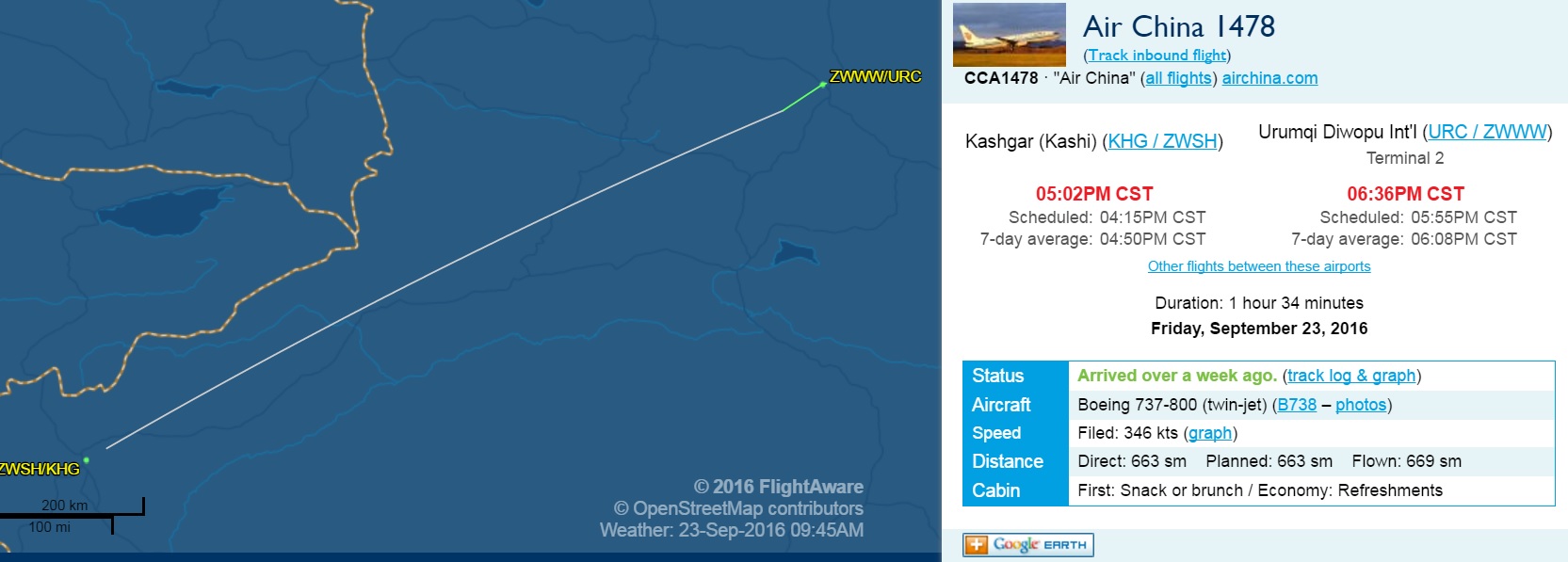On September 23 a passenger in his late 30s had an epileptic seizure on Air China flight CA1478 from Kashgar — the westernmost city in China near the border with Kyrgyzstan and Tajikistan — to Urumqi in Northwest China.
The passenger lost consciousness and was foaming at the mouth.

Flight crew made an announcement looking for any doctor that might be onboard. Tian Yu, a 38 year old from the Department of Rheumatology at Shanghai’s Longhua Hospital, responded. Doing his best Macguyver impersonation, he asked crew for a towel and a spoon. (Or is it Ford Prefect?)
He used the spoon, asked for toothpicks, and went to work with acupuncture:
Then he wrapped the spoon with the towel and put it in the patient’s mouth to stop him from biting his own tongue.
In order to prevent the patient from suffering continuous seizure, Tian asked the cabin crew to give him a few toothpicks.
With the pointy sticks, he managed to bring the patient around by stimulating several acupuncture points, including the baihui aperture and sishengcong aperture on top of the head.

Air China A320, Copyright: boarding1now / 123RF Stock Photo
Toothpicks were used in lieu of needles which weren’t onboard. He used the ‘toothpicks to apply pressure to key acupuncture points, including the baihui aperture and sishencong aperture, around the patient’s head in an attempt to “activate the brain”’.
The passenger regained consciousness after 5 minutes, the plane landed in Urumqi, and parademics met the aircraft. Of course he might have regained consciousness without the acupuncture.
Regardless, when you have limited tools to work with, you do the best you can — like the flight attendants who took down an upgraded passenger with an ice pick and a coffee pot.


Don’t discount acupuncture – had it used in an emergency to resolve an acute asthma attack. Don’t know the science of it, but it actually works.
I’m a neurologist actively practicing in the US… do not do what this doctor did. It is not recommended to place an item in a seizing patient’s mouth. The seizure probably would have ended regardless of what this doctor did. (The vast majority of seizures end on their own within 3 minutes or less).
He probably only jeopardized the patient’s health and put him at risk for aspirating an item or losing some teeth to biting down hard on a metal object. It is an old wives tale that you can swallow your tongue while seizing. I’m highly doubtful that the toothpicks did anything as well. Makes for great sensational journalism, though.
@KL hence my understated conclusion, “Of course he might have regained consciousness without the acupuncture.” 😉
I am a practicing pediatric neurologist in the US and I mostly treat patients with seizures. You should NEVER place anything in a patient’s mouth during a seizure. They will not swallow their tongues. It is an old wives tale. It is dangerous to do so, and I counsel families about this multiple times per day bc doing what this man did is dangerous. In the event of a seizure, a patient should be placed on his/her side in a safe place. Most seizures resolve before 5minutes– if not, the patient needs rectal Diastat or a benzodiazepine such as clonazepam. This doctor did not follow standard of care, and did not save this patient’s life.
This doctor sounds horrible
@Gary and about your ridiculously OVERSTATED clickbait title ‘doctor saves passenger’s life’???
jesus, you’re Gary f-ing Leff… do you really need to clickbait to get page views?!? or can you just not help yourself…
Good lord. Any way to “opt out” of Air China letting some quack touch you in a medical emergency? I thought doctors on board have to pre-register and be vetted before touching passengers. And shouldn’t flight attendant safety training include responding to a passenger having a seizure?
@Meera P
“If not, the patient needs rectal Diastat or a benzodiazepine such as clonazepam” is odd medical advice/
First, rectal Diastat (Valium) is a benzodiazepine. Second, there is no good way to use clonazepam to treat an actively seizing patient, since it is only available as an oral medication. Choices for treating a active seizure include diazepam (Valium), lorazepam (Ativan), or midazolam (Versed), all of which can be given by intravenous or intramuscular injection, or by an intranasal spray.
Was touched on above, but if you see someone having a seizure, put them on their side so oral secretions can naturally drain out. Move furniture away from them so they don’t injures themselves by striking it. Do not attempt to force their mouth open. They may not be breathing normally during the seizure and may in some cases look dusky or blue, but opening their mouth isn’t going to fix that and can break teeth or cause bleeding. Most seizures last less than 5 minutes (and many just 1-2 minutes). Call for help unless there’s reason to believe (from a responsible family member) that the patient has a history of seizures and this is not unusual for them. Patients who seize will often be initially unresponsive then sleepy, confused, or agitated for minutes after the seizure stops. This is normal.
@ KL
@Gary Leff
Just so I understand, neither of you has actually studied acupuncture or has taken the time to research its potential benefits/uses, but you’re both highly doubtful that the toothpicks did anything? Makes sense.
@ Meera P is exactly correct.
What this doctor did was inappropriate “treatment” and could’ve made this person’s condition much worse
I like turtles.
WTF was this doctor thinking? That’s not how u treat a seizure. Everyone knows ur supposed to use three grapes and troll doll. I had a coworker go into a seizure while we were on lunch. I sprung into action and stuffed a grape in each ear and the third grape I shoved up his right nostril. I then grabbed the troll doll off my key chain and started tickling his left nostril. After 6 minutes he came out of his seizure. Yup that’s right I saved his life.
Not odd advice at all, CT dub. I think you misunderstood. First line rescue home seizure medication is rectal diazepam for kids (most adults do not want this). If younger than 2 years, you can use intranasal versed, liquid clonazepam or ODT clonazepam depending on weight. Adults usually get clonazepam ODT for home at our institution. I am aware that Diastat is rectal diazepam. Clonazepam comes as an oral dissolving tablet and is often preferred for adults, who usually are not prescribed a rectally administered benzo as a home rescue. While Ativan has an oral prep, it does not come as an ODT so it is used IV as a rescue medication in the inpatient setting. It is first line for our inpatient status protocol. Intranasal versed is often prescribed to infants less than 2 years of age because Diastat isn’t used in kids that young. It’s a pain to administer because you have to draw it up and remember that you lose some medication in the atomizer. In my adult neurology training, we never use intranasal versed. Home rescue medication used for them is clonazepam ODT at our institution. Most kids (and adults) get treated at 5 minutes unless the patient has a history of status unless treated earlier.
doctor here: Accupuncutre as treatment: certainly no harm
stuffing a wrapped spoon in the mouth: certainly DANGEROUS
“saved passenger’s life”–almost certainly not
I’m a firefighter/EMT. He didn’t do anything. We do not put anything in the mouth of a person seizing. Most seizures end on their own within a couple minutes anyway. Regaining consciousness after 5 minutes is nothing unusual at all. I see it all the time. No acupuncture needed.
Please stop promoting this article. In fact, remove it completely. Spreading bad information about what to do when someone has a seizure is dangerous and irresponsible.
@ Meera P
Your advice may be a little “inside baseball” for the general readership of this blog, and we come at this from different perspectives. You likely provide advice to families who need to treat seizures at home that may occur often; I’m an ER doctor where, if the patients are still seizing by the time they arrive in the ER, it’s a problem that needs to be stopped immediately. I’d argue that the closed and remote nature of an airplane means that injectable medications would be greatly preferred by any medical professional since they are both faster and more effective. But I’d agree that excluding a better alternative or for use by a lay person an oral medication dissolved in the mouth to treat a seizure is an option.
There is not a requirement for a medication to treat seizures in the FAA required basic medical kit for airplanes. http://www.faa.gov/documentLibrary/media/Advisory_Circular/AC121-33B.pdf
That required basic kit already contains a number of injectable medications designed for use only under the care of a medical professional or under ground medical guidance, including: diphenhydramine (Benadryl), atropine, dextrose, epinephrine (both intravenous and intramuscular strength), and lidocaine. The Aerospace Medical Association recommends including an anti-seizure medication in the airplane medical kit but their suggestions are advisory and not required. It is suggested to be an injectable, but the guidelines also discuss that an orally disintegrating tablet may be substituted to facilitate treatment by a non-medical professional.
https://www.asma.org/asma/media/AsMA/Travel-Publications/Medical%20Guidelines/In-Flight-Medical-Care-July-2016.pdf
However, while we cannot predict what medical equipment and medications will be available on any given flight, I’m sure we can agree that toothpicks are not at the top of our wishlist.
It is possible for someone coming out of a grand mal seizure to become combative. A man observing a third grade class I was co-teaching years ago slumped to the floor seizing during our reading circle. The children were quickly ushered from the room. Luckily there were 2 other teachers in the room at the time, one of who knew how an incident like this could progress. We turned this man on his side, but as he came out of the seizure, he was clearly disoriented and became very agitated and combative. It took all three of us to restrain this sufferer until two EMTs arrived, fortunately within minutes. They had to strap the man face down on the stretcher in order to get him into the ambulance. This may have been an extreme case, but it is something to be aware of.